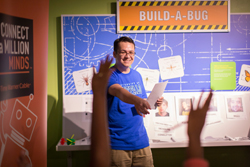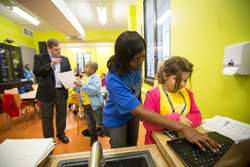Jinkies!
Middle schoolers solve a mystery and learn about cybersecurity
By Kevin Manne

David Murray, associate professor of management science and systems, leads students from the Boys and Girls Club of Buffalo through an exercise in password security. (Photos: Tom Wolf)
It was like a classic episode of the cartoon Scooby-Doo: There was a mystery afoot that the gang needed to solve.
But in this case, the gang was a group of 50 middle school students from the Boys and Girls Club of Buffalo. David Murray, associate professor of management science and systems in the School of Management, led them through a series of exercises to solve the case of the missing exhibit piece at the Buffalo Museum of Science.
The workshop, held as part of National Cybersecurity Month, was a fun and engaging way to teach the kids about computer security, how to stay safe online and the demand for careers in the cybersecurity field.
Eight UB student volunteers from the School of Management and the Department of Computer Science and Engineering—Stacey Askey, Joseph D'Amato, James Droste, Aaron Fiebelkorn, Victoria Kisekka, Alexandra Mazzei, Rohan Shah and Bich Vu—facilitated four different workshop stations.
At one station, participants learned how passwords using words from the dictionary are easily cracked by computer software. Passphrases, created by taking the first letter from each word of a sentence, are easy to remember and much harder for nefarious computer users to figure out.

School of Management student Aaron Fiebelkorn answers questions from students from the Boys and Girls Club of Buffalo about how to stay safe online.
In the other exercises, the kids decrypted a secret message, recovered deleted information and matched up photos of cybercriminals with their online pseudonyms.
As they completed each exercise, the students received a clue to help solve the mystery. The last clue revealed that the final piece of evidence was right on the back of the name badges they were wearing—invisible to the naked eye and revealed only by ultraviolet light.
"Digital technology is a daily part of the lives of each and every person growing up today," says Murray. "We wanted to use this opportunity to show how important it is to know about the threats that are out there and how to keep your online accounts safe."
The event was one of 25 cybersecurity workshops that Murray presented at middle schools throughout the Buffalo Niagara region as part of a partnership between the School of Management and Time Warner Cable. The series is funded by Connect a Million Minds, Time Warner Cable's five-year, $100 million cash and in-kind philanthropic initiative to connect young minds to science, technology, engineering and math.

Victoria Kisekka, a School of Management PhD student, helps a student from the Boys and Girls Club of Buffalo to see how quickly computer software can crack her password.
Cyberthreats are on the rise, creating an urgent need for professionals with the technical and managerial skills to protect national and business interests, according to Murray. One way Murray hopes to help meet this escalating demand is by introducing bright young students, especially girls and minorities, to the subject of information assurance through the workshops, and encouraging them to pursue career opportunities in the burgeoning field.
The workshops draw upon the expertise in the School of Management's MBA option in information assurance, its Sleiman Information Assurance Laboratory and the UB Center of Excellence in Information Systems Assurance Research and Education, which is recognized as a national center of excellence by the National Security Agency.
Time Warner Cable previously funded the School of Management's Western New York Cybersecurity Workshop Outreach program, which ran from 2009-12. That program was piloted with a grant from the National Science Foundation (NSF) awarded to H.R. Rao, professor of management science and systems, as well as two other UB professors, Sharmistha Bagchi-Sen, professor of geography, and Shambhu Upadhyaya, professor of computer science and engineering.
Since 2004, the Department of Homeland Security, in cooperation with the National Cyber Security Alliance and the Multi-State Information Sharing and Analysis Center, has designated October as National Cybersecurity Awareness Month. It is designed to engage and educate public and private sector partners through events and initiatives with the goal of raising awareness about cybersecurity and increasing the resiliency of the nation in the event of a cybersecurity incident.
